|
FAQs about Morays Eel Identification
7
Related FAQs: Moray IDs 1, Moray IDs 2, Moray
IDs 3, Moray IDs 4, Moray IDs 5, Moray IDs 6,
Moray IDs 8,
Moray IDs 9, &
Moray Eels 1, Moray Eels 2, Moral
Eels 3, Moray Selection,
Moray Behavior, Moray Compatibility, Moray Systems, Moray Feeding, Moray Disease, Moray Reproduction, Zebra Moray Eels, Snowflake Morays, Freshwater Moray Eels,
Other Marine Eels,Related Articles: Moray
Eels, Zebra Morays, Snowflake Morays, Ribbon Morays, The "Freshwater" Moray
Eels, Freshwater Moray
Eels by Marco Lichtenberger,
Other Marine
Eels,
|
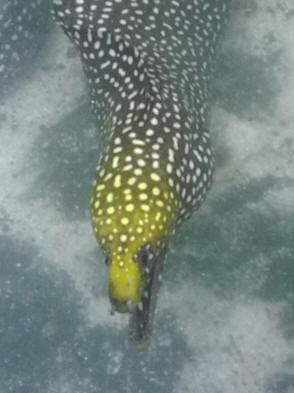
|
|
(Another moray) What kind of Moray eel is this?
8/23/17
Hello Bob, Neale and all you good people in WetWebMedia,
<Hi Ben.>
Yesterday a guy in Predator Fish forum in Indonesia is offering this lovely
Moray for sale. He said it's a locally-caught from a river in West Java,
Indonesia. I am familiar with Gymnothorax Polyuranodon, which commonly
caught in our rivers, and Gymnothorax Tile, which is not unknown around here,
but this one looks like a different species. So, what do you think?
Perhaps a sea moray that took a wrong turn, and ended up in a river away from
home?
<Gymnothorax undulatus, a marine species, which occasionally is found in
brackish waters.>
Thank you and Best Regards, Ben
<Cheers, Marco.>
|
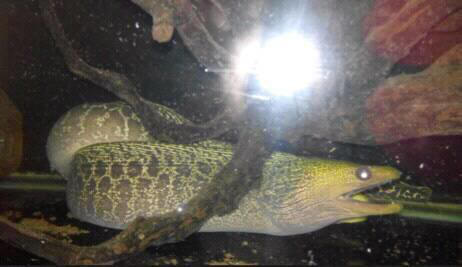 Re: (Another moray) What kind of Moray eel is this?
8/24/17
Hello Marco, and all you good people in WetWebMedia,
<Hi Ben.>
Thank you for the identification. So, it's a G. undulatus, a fish which we
usually found in coral reefs, but apparently has the ability to penetrate
far inland to rivers. I have no idea why would they do that, though. Isn't
it easier to find prey on the sea, rather than in the murky waters of
Java's muddy rivers? What do you think dear Marco?
<Estuaries are not the worst places to hunt for food if you can endure the
lower salinity, since rivers transport a lot of nutrients into the oceans.
There's quite a number of predatory marine fishes, which swim into rivers,
and there is a bunch of Gymnothorax species among them.>
Again, many thanks!
<Welcome.>
Best Regards,
Ben Haryo
<Cheers, Marco.>
|
|
Eel id 8/13/17
Just seeing if you could help with this eel that our divers sent Collected out
of Hawaii
<Neato! After diving in Hawaii for decades, I've seen most of the Muraenids of
the "fiftieth State", but not this juvenile; likely Gymnothorax eurostus... HI
IS the "land of the puhi" (eel), particularly Morays, with some 32 species. Have
written articles on the topic. Thank you for sharing.
Oh, am going to ask MarcoL here for his ID help as well. Bob Fenner>
|
.JPG)
.JPG) |
|
Eel id /Marco 8/13/17
Just seeing if you could help with this eel that our divers sent
Collected out of Hawaii
<Those pictures are really small and better pictures would be needed to be sure,
but I agree with Bob: most likely Gymnothorax eurostus. Cheers, Marco.>
|
|
What kind of Moray eel is this? 6/15/17
Good afternoon Neale and all the good people at WetWebMedia;
<Howsit Ben?>
In an Indonesian discussion forum, I found this picture, the guy who posted it
said that he fished this moray eel in a river, several kilometres from the river
mouth/estuary. I wonder what Moray eel is this? It does not looks like
"freshwater" moray (Gymnothorax polyuranodon, we call it belut muara), so it
might be a new species?
<Mmm; I do think this is a Synbranchid eel (not a Moray): Ophisternon bengalense
http://www.fishbase.org/summary/22496
Best Regards,
Ben
<Cheers, Bob Fenner>
|
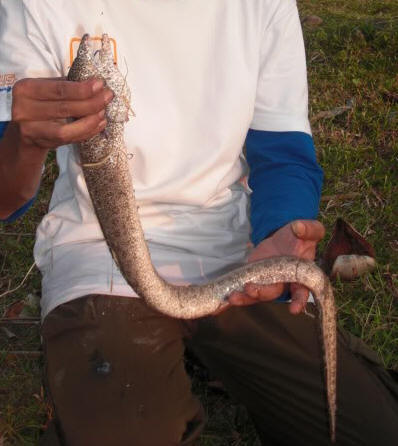 |
|
Re: What kind of Moray eel is this?
6/15/17
Hello Bob! Thank you for the reply. That was quick! And very informative too. I
never heard about this fish. We learn something new everyday. It's a very
fierce-looking fish, no wonder we all confused it with the moray!
<Synbranchids do look very similar... Neat animals (and tasty!)
Again, many thanks! *bowing*
Best Regards,
Ben
<Sama sama my friend. BobF>
|
|
I'd of this Eel plz 2/2/17
Hi
<Hi Harvey. Sorry for the delayed reply. Just saw your email today.>
Can you please tell me if you can ID this eels. I'm finding close resemblance to
other eels from Enchelycore sp to a few Gymnothorax sp like i.e. kidako and few
others. here I've attached video and picture.
<Think I see a dark blotch behind the eye and a large white blotch below it.
These are typical characters of G. zonipectis. Cannot be sure
though, the material is out of focus and has little contrast. Hope that helps.>
Kind regards Harvey
<Cheers, Marco.>
|
 |
|
re: I'd of this Eel plz 2/2/17
Marco; howsit? Do you have the photo of this email to send me? I gave up and
deleted from the editing page on WWM... Danke, B
re: I'd of this Eel plz 2/2/17
Can't complain. I put the email with the picture in the "Email with Images"
folder after I answered it.
<Ahh; thank you>
Strangely email from WWM does not arrive at my standard email account (yes, I
also had a look at the spam folder), lately.
Will have a look at it. Take care. Marco
<Thought perhaps you'd gone on holiday. Cheers mate. BobF>
re: I'd of this Eel plz 2/2/17
Have found the culprit (a filter in my system) and removed it. Holiday? Now
that's a word I haven't heard in a long time. Hehe.
Cheers, Marco.
<Gots to get out and re-charge Marco! Haul on out dive-adventure traveling with
us; the trips are posted on the Facebook friends site as you know.
Cheers, BobF>
|
|
Moray Eel Identification Help 11/26/15
<Tay! WHY 18 megs of blurry pix? Mate, we have a file size limit that you've
exceeded and crashed our mail server.... but I do so like Morays, diving in that
part of the world>
Hi,
I have just been diving in the Sultanate of Oman and have been trying to
identify the species that I saw. I am having trouble identifying the species of
moray eel. If possible, please can you help. I have attached photos to this
email. Please note that the 3 photos of the swimming eel are a different eel to
the one within the rocks. Any help would be greatly appreciated.
Many thanks,
TB
<The one in the rocks appears to be an Oman Moray, Gymnothorax megaspilus...
on the basis of dentition (see Randall's Coastal Fishes of Oman, or
Fishbase.org) and dendritic markings.... the free-swimming specimen I make out
as a Highfin Moray, G. pseudothyrsoides.... on the basis of its body
"chunkiness" (head into length ratio), yellowish cast color and brown spotting;
as well as the prominently "taller" dorsal fin.
Will send to MarcoL for his separate input. Bob Fenner>
|

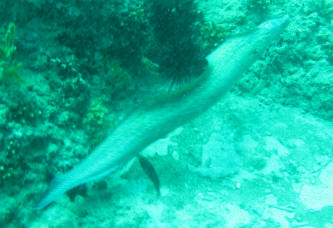 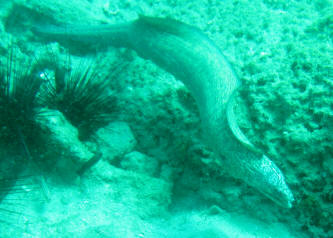
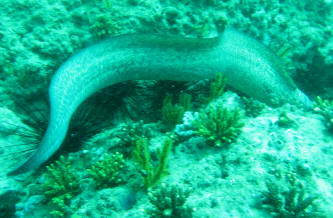
Re-sized, cropped, spiffed.
|
Re: Moray Eel Identification Help /RMF, cranky
boy
12/17/15
Dear Bob and Marco,
<Tay.... see where you find to write us Re limiting, fixing your image files....
Yours are an order of magnitude too large and uncropped. Why?>
Thanks a lot for your response. I apologise for the poor quality of images -
they were the best I could capture at the time. Am I right in thinking the Oman
Moray is a rare species?
<In the USA, yes>
I have tried to read up on it, but there doesn't seem to be too many findings,
either online or in any books I have
checked.
<Of the hundreds of species of Muraenids, only a few are commonly offered>
I actually saw two separate morays during the dive and I think the other one was
also the same species. I have attached a photo, would you mind confirming (sorry
again about image quality). Also, please can you explain the difference between
the two species in a little more detail. I have read up on both and looked at
pictures etc but still can't really tell them apart.
Thanks a lot in advance guys.
Cheers,
Tay
<The pic you sent along is too poor. FIX (crop, spiff up) your image/s and
re-send. I'll turn to Marco (in Germany) for his input. Bob Fenner>
|
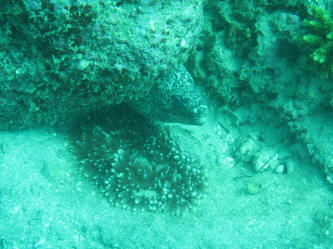
.JPG) crop
crop |
|
Re: Moray Eel Identification Help
/RMF, cranky boy
12/17/15
Also, I just found a shot of another tail. Is it possible to tell if this a
Highfin Moray?
Kind regards,
Tay
<Ditto (what I wrote re your images in our last message). B>
|
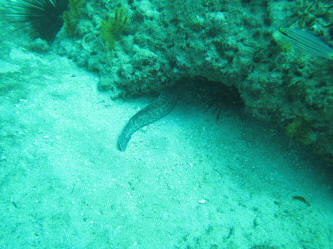
.JPG) crop
crop |
|
Re: Moray Eel Identification Help /Marco
12/19/15
Also, I just found a shot of another tail. Is it possible to tell if this a
Highfin Moray?
Kind regards, Tay
<Probably a Oman moray, but given only the tail is visible, it's not sure.
Cheers, Marco.>
Re: Moray Eel Identification Help /Marco
12/19/15
Dear Bob and Marco,
<Hi Tay.>
Thanks a lot for your response. I apologise for the poor quality of images -
they were the best I could capture at the time. Am I right in thinking the Oman
Moray is a rare species?
<Not in the area you visited.>
I have tried to read up on it, but there doesn't seem to be too many findings,
either online or in any books I have checked. I actually saw two separate morays
during the dive and I think the other one was also the same species. I have
attached a photo, would you mind confirming (sorry again about image quality).
<My guess is G. pseudothyrsoideus aka Highfin moray.>
Also, please can you explain the difference between the two species in a little
more detail.
<Did you look them up on FishBase?
http://www.fishbase.org/summary/SpeciesSummary.php?ID=26984 and
http://fishbase.org/summary/5395
. The Oman moray has a large black spot and dendritic markings. The Highfin
moray has clusters of dark spots and no big black spot. Randall's Coastal fishes
of Oman is recommended on fishes from this area.>
I have read up on both and looked at pictures etc but still can't really tell
them apart. Thanks a lot in advance guys. Cheers, Tay
<Hope this helps. Marco.>
|
|
|
Posting a question; Moray ID 10/3/15
Hi ,
I wanted some help with a moray ID but could not find a way to post.
Please enlighten.
Regards,
Edwin
<Oh; this is it. Marco? BobF>
Posting a question
10/3/15
Hi ,
I wanted some help with a moray ID but could not find a way to post. Please
enlighten.
Regards,
Edwin
<Could be a Echidna delicatula like this one:
https://www.flickr.com/photos/8473381@N08/3797531634 But the picture
does not show enough detail to be sure.
Cheers, Marco.>
|
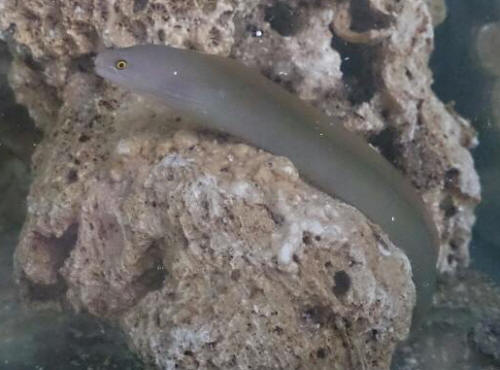 |
|
Re. Moray ID 10/4/15
Marco,
<Edwin>
I think you're spot on !
<Glad to be helpful.>
The reason I am saying this is because of the yellow eyes. I have spent hours
searching for a small moray (this one is about 5 inches) with yellow eyes and
found nothing. Thanks and that's why I love the WetWebMedia site !
Regards, Edwin
<Thanks for your kind words. Cheers, Marco.>
|
|
Unidentified moray
1/28/15
Hello,
<Howsit?>
I have a question regarding the species of a moray that someone local is
looking to find a new home for. My knowledge on moray species is better
than average, but I can't seem to pin this one down, and I thought the
ever knowledgeable crew at WWM might be able to help. I don't know much
about this animal, only that it's approximately 3 feet long, fairly
girthy and has been in captivity at least 2 years. It was also kept with
numerous damsels and a large crab with no casualties. Other than that I
have two pictures until this weekend. I'd appreciate any insight you
might have into what exactly I'll be picking up. Thank you in advance!
<Mmm; at first my guess was on Gymnothorax undulatus... but... looking
through the pix on Fishbase's coverage of the family... the age, size,
the "spotted-ness"; am sending this to MarcoL who penned a book on
Muraenids... BobF> |
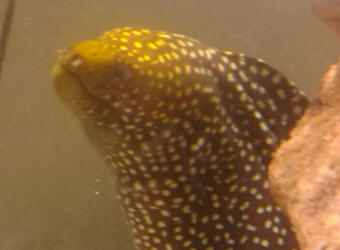
 |
|
Re: Unidentified moray
1/28/15
Hello,
<Hi>
I have a question regarding the species of a moray that someone local is
looking to find a new home for. My knowledge on moray species is better than
average, but I can't seem to pin this one down, and I thought the ever
knowledgeable crew at WWM might be able to help.
<Will try, but is difficult from the pictures sent.>
I don't know much about this animal, only that it's approximately 3 feet
long, fairly girthy and has been in captivity at least 2 years. It was also
kept with numerous damsels and a large crab with no casualties. Other than
that I have two pictures until this weekend. I'd appreciate any insight you
might have into what exactly I'll be picking up. Thank you in advance!
<At first glance it looked like a G. meleagris, which often have yellowish
heads and snouts. The second picture does not seem to show a white mouth.
So, this one can be ruled out. A few years back a few Enchelycore nycturanus
appeared in the aquarium trade. They also have yellow heads and white round
spots, but their heads looked quite Enchelycore-like, while your specimen
looks like a typical Gymnothorax. Aside that, G. johnsoni is the most
similar species I can think of. Nothing you see every day. Maybe
you can send better pictures if you decide to pick it up. Cheers, Marco.>
Re: Unidentified moray 1/28/15
G. meleagris is one species I'd thought about but I'd never seen one with
any more than a small amount of yellow on the tip of the snout. The white
spots usually carry all the way to the tip of the snout as well from what
I've seen. The lack of a white mouth is most diagnostic of course. Is there
a good website with decent pictures of G. johnsoni?
<I am not aware of one. I know it mostly from scientific literature without
good pictures, just descriptions. I can rule out the other white spotted
Gymnothorax species coming to mind. Too bad it is unknown where it was
caught. Might even be a new one. There's a number of moray eels still
waiting for their first descriptions.>
I haven't been able to find much on this species and most pictures are of
dead specimens. I'll be picking this fish up over the weekend and I'll make
sure to send you the best pictures I can. Thank you, Paul
<Eyes, gill spot (if there), tail and a good lateral picture would be good.
Looking forward to it. Cheers, Marco.>
|
Re: Unidentified moray 2/3/15
Hello all,
<Hi Paul.>
I have some better pictures of the eel in question.
<Thanks.>
I was unable to get a decent lateral shot or tail shot but I can say the
pattern is the same on the entire body and tail. The yellow on the head
is less pronounced but that could be due to being stressed from moving -
on top of normal moving stress he managed to bash off the top of the tub
he was in and escape into my car on the drive home.
<Sounds like you had some fun there.>
I'm thinking G. prionodon is the closest match I can get not knowing the
collection location.
<I know G. prionodon and this does not look like one. Has a much
different head shape. Still think this is G. johnsoni or something new.>
I'm still trying to get a hold of the owner of the now closed store that
sold him.
<Good plan. Knowing the location makes ID much easier, especially with
species rarely seen.>
Thank you, Paul
<Welcome. Marco.> |
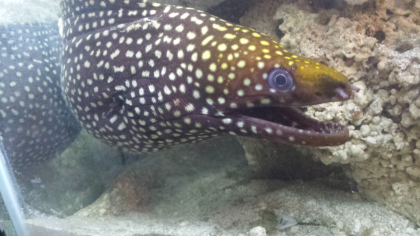
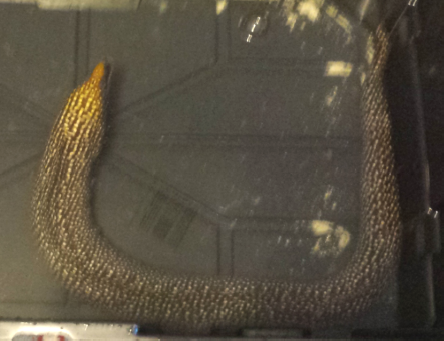 |
|
|
|

